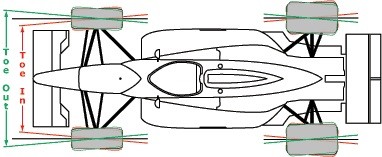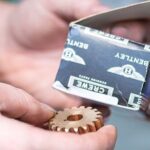Car alignment is a critical aspect of vehicle maintenance that significantly impacts handling, tire wear, and overall driving safety. It involves adjusting the angles of your vehicle’s wheels to the specifications recommended by the manufacturer. Understanding the key Car Alignment Parts and angles—toe, camber, and caster—is essential for any car owner or enthusiast looking to maintain their vehicle’s peak performance and longevity.
Decoding Toe Angle in Car Alignment
Toe refers to the direction your tires point in relation to the center line of your vehicle when viewed from above. It’s measured as the difference in distance between the front and rear of the tires on the same axle. Imagine looking down at your car from a bird’s eye view; toe describes whether your wheels are pointing slightly inwards or outwards.
- Toe-in: The front of the tires are closer together than the rear.
- Toe-out: The front of the tires are further apart than the rear.
- Zero Toe: The tires are perfectly parallel to each other and the vehicle’s centerline.
While individual wheels can exhibit toe-in or toe-out, we also consider total toe and thrust angle for a set of wheels (front or rear). Total toe is the sum of the toe angles of each wheel on an axle. Thrust angle, primarily relevant to rear-wheel drive vehicles, is the direction the rear axle is pointed relative to the vehicle’s centerline. Misalignment in thrust angle, where rear wheels point in different directions, can cause the vehicle to steer sideways, even with the steering wheel straight.
Tie rods are the primary car alignment parts controlling toe. Typically, a slight toe-in is preferred for front wheels as it enhances high-speed stability. However, excessive toe, in either direction, leads to rapid and uneven tire wear, reduced fuel efficiency, and compromised handling. Modern independent rear suspensions often have adjustable toe settings, utilizing mechanisms like cam bolts on control arms or tension arms. Older or simpler rear suspension systems, like those with live axles, might have limited or no toe adjustability.
Camber Angle and Its Role in Vehicle Handling
Camber is the angle of your tires relative to the vertical axis of the vehicle when viewed from the front. It describes whether the top of the tire leans inward or outward.
- Negative Camber: The top of the tire tilts inward towards the vehicle.
- Positive Camber: The top of the tire tilts outward away from the vehicle.
- Zero Camber: The tire is perfectly vertical.
Most modern vehicles are designed with a slight negative camber. This is because negative camber optimizes tire contact with the road during cornering, enhancing grip and improving handling. However, excessive negative camber can lead to increased wear on the inside edge of the tires. Conversely, positive camber, often seen in agricultural vehicles like tractors for specific terrain handling, can reduce steering response in regular vehicles.
Camber adjustment is primarily found in vehicles with independent suspensions. MacPherson strut suspensions may offer limited camber adjustment through aftermarket car alignment parts like special mounting plates that allow shifting the strut mounting position. Double-wishbone suspensions, known for their superior handling characteristics, often incorporate cam bolts on the upper control arms for easier camber adjustments. Solid axle suspensions generally offer no camber adjustment unless modifications or specialized car alignment parts are installed.
Caster Angle: Impacting Steering Stability
Caster is the angle of the steering pivot axis relative to the vertical axis when viewed from the side of the vehicle. Imagine an imaginary line running through the upper and lower ball joints or strut mounts; caster is the angle of this line compared to true vertical.
- Positive Caster: The steering pivot axis tilts rearward at the top.
- Negative Caster: The steering pivot axis tilts forward at the top.
- Zero Caster: The steering pivot axis is perfectly vertical.
Positive caster is almost universally used in passenger vehicles. It contributes significantly to directional stability at high speeds and enhances steering self-centering. As the wheels turn, positive caster causes the vehicle to raise slightly, and gravity then helps to return the wheels to the straight-ahead position after a turn. Negative caster would have the opposite effect, making the steering feel lighter but potentially unstable, especially at higher speeds, and can even lead to a dangerous “hardover” condition where the steering may aggressively turn into a corner.
Caster is generally the least adjustable of the car alignment parts. It’s primarily determined by the suspension geometry design. Adjustments are rarely needed unless there is damage to suspension components or wear in bushings. While some double-wishbone suspensions might offer slight caster adjustment, MacPherson strut and solid axle systems typically do not without aftermarket car alignment parts.
Essential Car Alignment Parts to Inspect for Optimal Performance
Maintaining proper car alignment is not just about angles; it’s also about the condition of various car alignment parts in your vehicle’s suspension system. Regular inspection of these parts is crucial for preserving alignment and ensuring safe and predictable handling.
-
Tie Rods and Tie Rod Ends: As the primary components for toe adjustment, tie rods and their ball joints are critical car alignment parts. Inspect for wear, looseness, and damage. Ensure jam nuts are properly tightened to prevent slippage and maintain toe settings.
-
Bushings: Suspension bushings, made of rubber or polyurethane, cushion and control movement in suspension joints. Worn or deteriorated bushings can cause unwanted suspension movement, leading to alignment changes and instability. Inspect control arm bushings, strut rod bushings, and sway bar bushings.
-
Ball Joints: Ball joints are spherical bearings that allow suspension components to move and pivot. Worn ball joints can introduce play in the suspension, affecting camber and caster angles, and causing noise and imprecise steering.
-
Wheel Bearings: Wheel bearings allow the wheels to rotate smoothly and are essential car alignment parts indirectly. Worn wheel bearings can cause wheel wobble and play, which can impact alignment readings and overall stability.
-
Control Arms: Control arms are structural car alignment parts that connect the wheel and suspension to the vehicle’s frame. Bent or damaged control arms, often from impacts, will severely disrupt alignment angles and require replacement.
Regular checks and timely replacement of worn car alignment parts are essential for maintaining proper wheel alignment, ensuring optimal tire life, safe handling, and a comfortable driving experience. Consulting a qualified mechanic for periodic alignment checks and suspension inspections is a proactive approach to vehicle maintenance, saving you from potential costly repairs and safety issues down the road.

